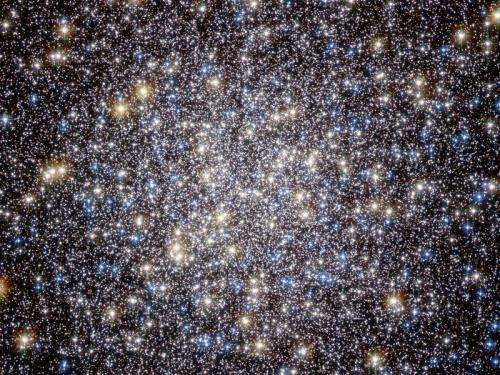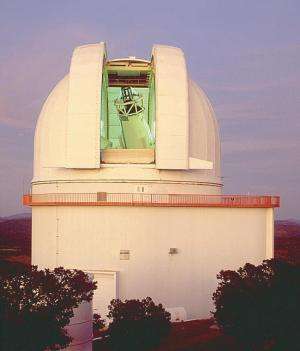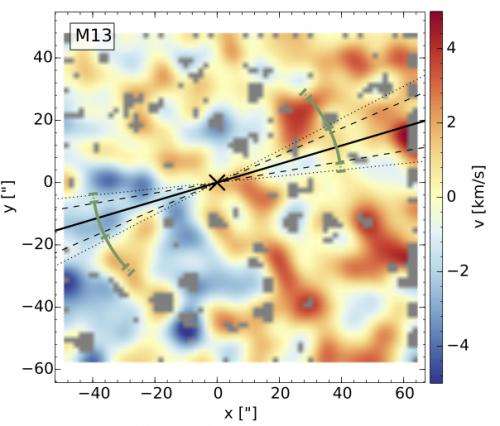Globular clusters rotate at heart

(Phys.org) —Astronomers from the University of Texas at Austin and Germany's Max Planck Institute for Extraterrestrial Physics (MPE) recently found a surprise when studying some of the oldest star clusters in our galaxy. The stars at the centers of these clusters are rotating around a common axis. It was previously thought any central rotation would have been long erased, leaving the central stars to random orbits. The work has been accepted for publication in the Astrophysical Journal Letters.
These "globular clusters" are ancient collections of up to a million old stars with simple chemical compositions, tightly bound together by gravity. Globular clusters orbit most galaxies, including our own Milky Way. Due to these clusters' old age and fairly spherical shape, with a strong concentration of stars towards the center, they have historically been viewed as simple systems. However, new observations keep revealing surprising results.
The team, led by MPE's Maximilian Fabricius and including Texas' Eva Noyola, observed 11 globular clusters from the University of Texas at Austin's McDonald Observatory with the Harlan J. Smith Telescope. They found that all of the clusters show this central rotation.
This result is "astonishing," Fabricius says. "We did not expect this; originally we observed these globular clusters to measure their central velocity dispersions"—that is, the random motions of stars within a cluster.

Noyola adds, "Theory and numerical simulations of globular clusters indicate that any central rotation should be erased on relatively short timescales. Because these globular clusters were formed billions of years ago, we would expect that any rotation signature would have been eradicated by now. Even though previous measurements showed some rotation in a handful of systems, they only probed the motion of stars in the outer regions."
The astronomers are about halfway through their project of studying 27 of the Milky Way's approximately 150 globular clusters. Their findings raise interesting questions about the formation history and evolution of globular clusters. None of the current theoretical models predict such a ubiquitous and strong rotation.
However, it is important to note that the 11 globular clusters studied so far do not include any so-called "core-collapsed" globular clusters. Core-collapse is a process that might eradicate rotation. Future observations of the remaining 16 clusters the team plans to study will shed light on this and other questions, such as a possible correlation between rotation and the position of a globular cluster inside our galaxy.

The new measurements of a these globular cluster cores were only possible with the help of the MPE-built instrument VIRUS-W, which was used in conjunction with the 2.7-meter Harlan J. Smith Telescope for this research. VIRUS-W allows the scientists to simultaneously measure more than 260 spectra in their field of view, determining the motion of stars to an accuracy of a few kilometers per second. That means that for a given globular cluster, one night at the Smith Telescope with an observing time of a few hours is enough to determine the velocity field at the core of a cluster.
More information: "Central Rotations of Milky Way Globular Clusters," Maximilian H. Fabricius et al., Astrophysical Journal Letters. Preprint: arxiv.org/abs/1405.1722
Journal information: Astrophysical Journal Letters
Provided by University of Texas McDonald Observatory




















